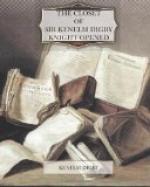At the Restoration he returned to England. He was still Henrietta Maria’s Chancellor. His relations with Cromwell had never broken their friendship; and probably he still made possets for her at Somerset House as he had done in the old days. But by Charles II there was no special favour shown him, beyond repayment for his ransom of English slaves during the Scanderoon voyage; and in 1664 he was forbidden the Court. The reason is not definitely known. Charles may have only gradually, but at last grimly, resented, the more he learnt of it, Digby’s recognition of the usurper.
He found happiness in science, in books, in conversation, in medicine, stilling and cookery. In 1661 he had lectured at Gresham College on The Vegetation of Plants. When the Royal Society was inaugurated, in 1663, he was one of the Council. His house became a kind of academy, where wits, experimentalists, occultists, philosophers, and men of letters worked and talked. This was the house in Covent Garden. An earlier one is also noted by Aubrey. “The faire howses in Holbourne between King’s Street and Southampton Street (which brake-off the continuance of them) were, about 1633, built by Sir Kenelme; where he lived before the civill warres. Since the restauration of Charles II he lived in the last faire house westward in the north portico of Covent Garden, where my lord Denzill Hollis lived since. He had a laboratory there.” This latter house, which can be seen in its eighteenth-century guise in Hogarth’s print of “Morning,” in The Four Hours of the Day set, is now the quarters of the National Sporting Club. There he worked and talked and entertained, made his metheglin and aqua vitae and other messes, till his last illness in 1665. Paris as ever attracted him; and in France were good doctors for his disease, the stone. He had himself borne on a litter to the coast; but feeling death’s hand on him, he turned his face homeward again, and died in Covent Garden, June 11, 1665. In his will he desired to be buried by his beautiful Venetia in Christ Church, Newgate, and that no mention should be made of him on the tomb, where he had engraved four Latin inscriptions to her memory. But Ferrar wrote an epitaph for him:—
“Under this tomb the
matchless Digby lies,
Digby the great, the valiant,
and the wise,” etc.
The Great Fire destroyed the tomb, and scattered their ashes.




